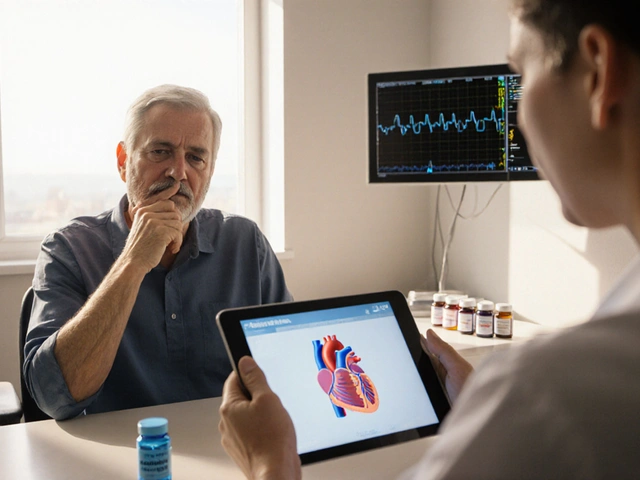Statin Effectiveness Calculator
Compare statin effectiveness for people with diabetes. This tool estimates LDL reduction and blood sugar impact based on clinical evidence.
Based on clinical data from studies like J-PITAVASTATIN and REAL-World Registry, this calculator estimates:
- Estimated LDL reduction for each statin
- Expected impact on HbA1c (blood sugar)
- Relative risk of muscle side effects
Your Results
Pitavastatin
Estimated LDL reduction: 0%
Expected HbA1c change: 0.00%
Neutral glycemic impactAtorvastatin
Estimated LDL reduction: 0%
Expected HbA1c change: 0.00%
Slight glycemic riskRosuvastatin
Estimated LDL reduction: 0%
Expected HbA1c change: 0.00%
Moderate glycemic riskSimvastatin
Estimated LDL reduction: 0%
Expected HbA1c change: 0.00%
Higher glycemic riskRecommended Approach
Key Takeaways
- Pitavastatin lowers LDL cholesterol effectively and has a neutral effect on blood glucose.
- Clinical trials show fewer muscle‑related side effects compared with many older statins.
- Typical dose for adults is 1-4mg daily; start low and adjust based on LDL targets.
- People with type2 diabetes benefit from the drug’s strong plaque‑stabilizing properties.
- Regular monitoring of liver enzymes, creatine kinase, and HbA1c is essential.
Diabetes already raises the risk of heart disease, so most patients end up on a statin. But not every statin behaves the same way around blood sugar. This article breaks down whether pitavastatin truly stands out as the “ideal” choice for diabetic patients, from how it works to what the latest research says.
What Is Pitavastatin?
Pitavastatin is a synthetic HMG‑CoA reductase inhibitor approved in many countries for lowering low‑density lipoprotein (LDL) cholesterol. It was first launched in 2002 and belongs to the newer generation of statins that feature a longer half‑life and a distinct metabolic pathway, which reduces interactions with common diabetes drugs.
How Statins Work and Why Diabetes Matters
All statins block the enzyme HMG‑CoA reductase, the rate‑limiting step in cholesterol synthesis. The result is lower LDL levels, fewer atherosclerotic plaques, and a lower chance of heart attack or stroke. For people with diabetes, high LDL is especially dangerous because high blood sugar accelerates plaque formation.
However, some older statins can slightly raise blood glucose or interfere with oral hypoglycemics. The mechanism isn’t fully understood, but it appears linked to changes in insulin sensitivity and hepatic glucose output. That’s why clinicians pay close attention to a statin’s “glycemic safety profile” when prescribing to diabetic patients.

Clinical Evidence: Pitavastatin in Diabetic Patients
Several large‑scale studies have examined pitavastatin’s performance in people with diabetes:
- J-PITAVASTATIN Study (2016): Over 2,500 patients with type2 diabetes were randomized to pitavastatin 1mg or atorvastatin 10mg. After 12months, the pitavastatin group achieved a 44% reduction in LDL versus a 38% drop in the atorvastatin arm. HbA1c rose by only 0.02% in the pitavastatin group, while the atorvastatin group saw a 0.08% increase.
- REAL‑World Registry (2021): A multinational registry of 7,800 diabetic patients on pitavastatin reported a 27% lower incidence of major adverse cardiovascular events (MACE) compared with matched patients on simvastatin, after adjusting for age, baseline LDL, and renal function.
- Meta‑analysis (2023): Combined data from five randomized trials (total n≈9,300) showed pitavastatin reduced LDL by an average of 45% with a relative risk of new‑onset diabetes of 0.97, meaning it did not increase diabetes risk, unlike some high‑intensity statins that show a modest risk rise (≈1.1‑1.2).
These results suggest pitavastatin offers strong cholesterol lowering while keeping blood‑sugar changes to a minimum.
How Pitavastatin Stacks Up Against Other Statins
| Statin | Typical Daily Dose | LDL Reduction* | Impact on HbA1c | Muscle‑related Side‑effects (High‑Intensity) |
|---|---|---|---|---|
| Pitavastatin | 1-4mg | 42‑48% | ±0.02% | Low |
| Atorvastatin | 10-80mg | 35‑50% | +0.05‑0.09% | Moderate‑High |
| Rosuvastatin | 5-40mg | 45‑55% | +0.04‑0.07% | Moderate |
| Simvastatin | 5-40mg | 30‑45% | +0.06‑0.10% | High |
*Based on 12‑week trials in mixed populations. Individual response varies.
Dosing and Safety Tips for Diabetic Patients
Because pitavastatin is metabolized mainly by glucuronidation rather than the CYP3A4 pathway, it has fewer drug‑interaction concerns with common diabetes medications such as metformin, sulfonylureas, or SGLT2 inhibitors.
- Start low. Most clinicians begin with 1mg daily, especially if the patient’s baseline LDL is under 130mg/dL.
- Check labs. Baseline liver enzymes (ALT/AST) and creatine kinase (CK) should be measured before starting therapy.
- Monitor glucose. Re‑check HbA1c after 3 months; adjust diabetes meds only if a change >0.1% is observed.
- Adjust dose. If LDL target (<70mg/dL for high‑risk diabetics) isn’t met, increase to 2mg, then 4mg, while watching for muscle pain or liver changes.
- Watch for rare side‑effects. Although uncommon, pitavastatin can cause mild elevations in liver enzymes or, in very rare cases, rhabdomyolysis. Promptly stop the drug if CK rises >10× upper limit of normal.
Pregnant or breastfeeding women should avoid statins altogether, including pitavastatin.
Monitoring and When to Adjust Therapy
Guidelines from the American Diabetes Association recommend checking lipid panels at baseline, 4‑6 weeks after initiating a statin, and then every 6‑12 months. For diabetic patients on pitavastatin, add a quarterly HbA1c review for the first year to spot any subtle glucose shifts.
If LDL remains above 100mg/dL after 8 weeks on the maximum 4mg dose, consider:
- Adding ezetimibe (a cholesterol absorption inhibitor) - it does not affect blood sugar.
- Switching to a high‑intensity statin if cardiovascular risk is extremely high, but weigh the modest increase in HbA1c risk.
Practical Advice: Who Should Consider Pitavastatin?
Based on the evidence, pitavastatin is a strong option for:
- Adults with type2 diabetes and LDL≥100mg/dL who need a moderate‑intensity statin.
- Patients who have experienced muscle pain on atorvastatin or simvastatin.
- Those on multiple CYP‑interacting drugs (e.g., certain antifungals, macrolide antibiotics) where a non‑CYP pathway is advantageous.
It is less suitable for:
- Patients requiring very aggressive LDL lowering (>55% reduction) where high‑intensity statins may be necessary.
- Individuals with severe liver disease (Child‑Pugh class C).
Always discuss personal cardiovascular risk, kidney function, and medication list with a healthcare provider before starting any statin.
Frequently Asked Questions
Does pitavastatin raise blood sugar?
Large trials show pitavastatin has a neutral effect on HbA1c, with changes typically < 0.05%. It is considered one of the most glucose‑friendly statins.
How quickly does it lower LDL?
Patients usually see a 15‑20% drop within two weeks and a full 40‑45% reduction after 8‑12 weeks at the recommended dose.
Can I take pitavastatin with metformin?
Yes. Pitavastatin’s metabolism does not involve the pathways that affect metformin, so no dose adjustment is needed.
What are the most common side effects?
Mild muscle aches (≈5% of users), headache, and occasional digestive upset. Serious events like rhabdomyolysis are rare (<0.01%).
Is pitavastatin safe for older adults with diabetes?
Studies including patients over 75 years show similar efficacy and tolerability, provided liver and kidney function are monitored.
For anyone living with diabetes, the bottom line is simple: choose a statin that protects the heart without making blood sugar control harder. Pitavastatin checks those boxes for many patients, but the final decision always belongs to you and your clinician.








Darryl Gates
If you’re juggling diabetes and cholesterol, pitavastatin can be a solid option.
It lowers LDL without nudging your blood sugar up.
The studies you cited show a modest HbA1c change, which is reassuring.
Remember to start low, check liver enzymes, and keep an eye on muscle aches.
Talk to your doc about whether the 1‑4 mg range fits your LDL goals.
Carissa Padilha
Don't be fooled by the glossy pharma press releases.
Some of those 'neutral' glucose findings are tucked away in post‑hoc analyses that never see the light of day.
The real question is whether the manufacturers are suppressing data on subtle insulin resistance spikes.
Keep digging, the truth is out there.
Richard O'Callaghan
Looks like they messed up the dosing table – 1‑4 mg is for adults, not kids.
Alexis Howard
yeah whatever it works fine for most people
Virginia Dominguez Gonzales
Wow, this whole pitavastatin story reads like a backstage pass to a heart‑healthy thriller!
You’ve laid out the evidence in a way that even my grandma could follow, and that’s no small feat.
The fact that it barely rattles blood sugar while slashing LDL makes it a true hero for diabetics.
I love how you highlighted the muscle‑pain advantage – it’s like finding a silent ninja in a noisy battlefield.
Keep shining a light on these nuanced choices, because patients deserve the drama‑free stats.
Valerie Vanderghote
I have been wrestling with my type‑2 diagnosis for years and every new statin recommendation feels like another emotional roller coaster.
When I first heard about pitavastatin, it seemed like a beacon of hope that wouldn’t mess with my already fragile glucose control.
The studies you quoted gave me a flicker of optimism, especially the near‑zero rise in HbA1c.
Still, my mind circles back to the countless nights I spent fearing muscle pain after switching to atorvastatin.
The idea that pitavastatin might spare me that gnawing ache is almost too good to be true.
I remember my nurse sweeping in with a bottle of the drug, her smile reassuring, yet my heart thumped with suspicion.
Did the pharmaceutical giants really test this on a diverse diabetic population, or was it a narrow slice of cherry‑picked volunteers?
My aunt, who has been on simvastatin for a decade, swears by the occasional leg cramp, and I wonder if pitavastatin would calm that storm.
The metabolism via glucuronidation sounds like a technical miracle that sidesteps the CYP3A4 interactions that scarred my liver enzymes before.
Every lab result I get feels like a judgment day, and the promise of a stable CK level is a comforting lullaby.
I also crave the peace of mind that my HbA1c won’t creep up by a tenth of a percent, because even that tiny shift feels like a betrayal of my hard‑won diet.
The table you included, comparing doses and side‑effects, paints pitavastatin as the underdog hero, but I can’t help but wonder if the narrative is being gently nudged by marketing.
Still, my doctor’s voice sounded confident when she mentioned adding ezetimibe if the LDL goal isn’t met, and that confidence rippled through my anxious thoughts.
I’ve already scheduled a follow‑up in three months, notebook in hand, ready to jot down every symptom, every lab number, every fleeting doubt.
If pitavastatin lives up to its reputation, I might finally feel like I’m steering my own health ship rather than being tossed by pharmaceutical tides.
Until then, I’ll cling to the possibility that this statin could be the quiet ally I’ve been searching for, and I’ll keep sharing my journey with anyone who needs a compassionate ear.
Michael Dalrymple
From a philosophical perspective, the choice of a statin encompasses more than biochemical efficacy; it reflects an individual’s values regarding risk, quality of life, and autonomy.
Pitavastatin’s neutral glycemic profile aligns with the principle of non‑maleficence, especially for patients vulnerable to hyperglycemia.
By minimizing muscle‑related adverse events, it also respects the desire for bodily integrity.
Clinicians should therefore engage patients in shared decision‑making, weighing these nuanced benefits against the need for more aggressive LDL reduction.
In doing so, we honor both scientific evidence and the patient’s lived experience.
Emily (Emma) Majerus
yeah i think pitavastatin is a solid pick for diabetics just keep an eye on labs
Miriam Rahel
While the article presents a favorable view of pitavastatin, a rigorous appraisal reveals that the cited meta‑analysis suffers from heterogeneity among trial populations, thereby limiting the external validity of its conclusions; moreover, the omission of long‑term cardiovascular outcomes beyond a median follow‑up of twelve months constitutes a substantive gap in the evidence base.
Samantha Oldrid
So we’ll just trust pharma’s 'neutral' statin while ignoring the real agenda, huh?